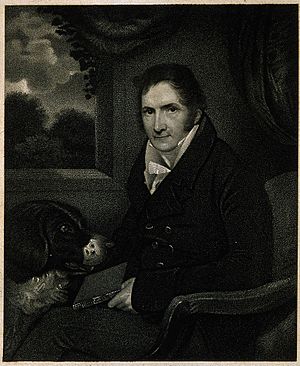James Macartney (anatomist) facts for kids
Quick facts for kids
James Macartney
|
|
|---|---|
 |
|
| Born | 8 March 1770 |
| Died | 6 March 1843 |
| Occupation | anatomist |
James Macartney (born March 8, 1770, in Armagh, died March 6, 1843, in Dublin) was a very important anatomist. An anatomist is a scientist who studies the structure of living things, like the human body. He first got involved with groups working for change in Ireland. But he soon decided to focus on studying medicine instead.
Contents
James Macartney's Early Life and Medical Training
James Macartney began his medical journey in 1793. He became an apprentice to William Hartigan, a leading surgeon in Dublin. Macartney also attended classes at the Royal College of Surgeons of Ireland. He helped create some displays for the college's museum.
In 1796, he moved to London to continue his studies. He attended lectures at famous medical schools, including those by John Abernethy. Through Abernethy's help, Macartney became a demonstrator of anatomy in 1798. This meant he helped teach students about the human body.
He became a member of the Royal College of Surgeons of England in 1800. He started working as a surgeon in London. From 1800 to 1811, he also taught about the anatomy of different animals and how their bodies work. In 1811, he was elected a Fellow of the Royal Society (FRS). This is a very high honor for scientists.
Becoming a Professor in Dublin
In 1813, James Macartney earned his medical degree from St. Andrews University. Soon after, he was chosen to be a professor of anatomy and surgery at the University of Dublin. He also became a doctor at Sir Patrick Dun's hospital.
He worked hard to improve the medical school there. He made it much better than it had ever been before. He stayed in these roles until 1837.
During his time in Dublin, Macartney faced some challenges. He was not allowed to become a fellow of the Royal College of Surgeons in Ireland. However, he was made an honorary fellow of the Royal College of Physicians of Ireland in 1818. He also received another honorary medical degree from the University of Cambridge in 1833.
He sold his collection of anatomical specimens to Cambridge University in 1836. The University of Dublin had decided not to buy it. James Macartney passed away in Dublin on March 6, 1843.
Macartney's Important Discoveries and Contributions
James Macartney was a brilliant anatomist and scientist. He was ahead of his time in understanding biology. Professor Alexander Macalister, another expert, praised his work. He said Macartney's descriptions of how blood flows in birds were excellent. He also noted that Macartney's work on mammal anatomy was very insightful.
Macartney made several key discoveries:
- He found the fibrous texture of the brain's white matter.
- He discovered how nerve fibers connect to the brain's grey matter.
- He gave the first good explanation of how animals like cows chew their cud (ruminate).
- He found many small glands in the digestive systems of mammals, especially rodents.
Macartney also played a big part in shaping the Anatomy Act of 1832. This law helped regulate the study of human anatomy. It made sure that bodies used for study were obtained legally and respectfully.
James Macartney's Writings
James Macartney wrote many important books and papers. These helped share his knowledge with other scientists and students.
Some of his main works include:
- Lectures on Comparative Anatomy (1802, 2 volumes): This was a translation of lectures by another famous anatomist, Cuvier, which Macartney oversaw.
- Observations on Curvature of the Spine (Dublin, 1817).
- A Treatise on Inflammation (London, 1838): This book discussed how the body reacts to injury or infection.
He also wrote many articles for the Philosophical Transactions. This was a very important scientific journal. He contributed many articles on comparative anatomy to Abraham Rees's Cyclopædia (1802–1819). This was a large encyclopedia of knowledge.
His articles for the Cyclopædia included:
- Anatomy, Comparative and Anatomy, Vegetable (Vol 1), 1802
- Bezoar and Beast (Vol 2), 1802/3
- Birds, anatomy (Vol 3), 1803/4
- Branch, Bud and Bulb, all vegetable anatomy (Vol 5), 1805
- Classification of animals for comparative anatomy (Vol 8), 1807
- Fish or Fishes, Anatomy of (Vol 14), 1810
- Incubation in comparative anatomy (Vol 19), 1811
- Mammals, anatomy of (Vol 22), 1812
Macartney noted that he was paid more than other writers for the Cyclopædia. This was because few others understood comparative anatomy as well as he did. His former student, William Lawrence, helped by writing articles on insects, reptiles, and worms.

